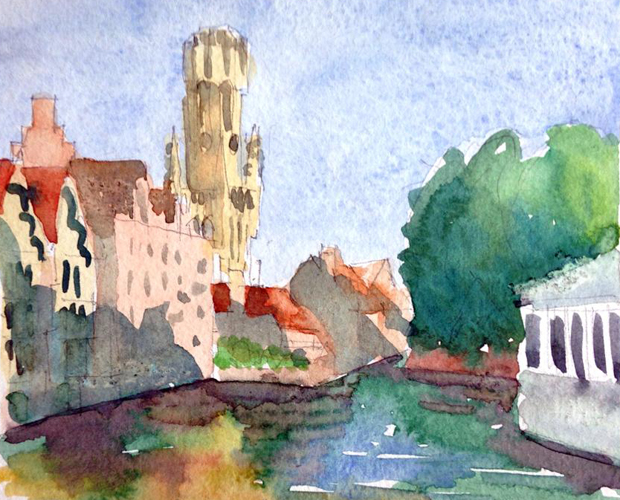In my master’s thesis, I wrote about two properties of the materials we build with: denotative and connotative. Mostly, we think of building materials as themselves – a brick is a brick, a steel beam is a steel beam. But I discovered another, subtler quality – what the material connotes, the assorted cultural values and meanings that are assigned to it.
What I didn’t know at the time – and have been discovering lately – is this is just the tip of the iceberg, the human story about that material. In reality, everything is animate, even bricks and steel beams, and certainly the trees and ore and fire from which they are made. Materials awaken something within us, because our senses reach out to and are seen and touched by them, in ongoing but unacknowledged communication.
My thesis being an academic paper, I had to support my argument. Luckily, Norris Kelley Smith had written an outstanding book about Frank Lloyd Wright, who was more “out there” about his feelings for materials. He openly spoke about the aliveness of wood, for instance, which got me thinking about trees and forests and fairy tales. And that scene in the “Wizard of Oz,” when the trees rage at Dorothy for picking their apples.
Smith said that Wright understood the two qualities of materials. He called them “Hellenic” and “Hebraic,” after the cultures that most closely identified with idealized form and inner truth, respectively. These are oversimplifications, but my point is, even back then, I sensed that we can bring more to the selection of materials than a dry functionalism. There is spirit in matter. As it happens, matter is spirit – but I wasn’t aware of that at the time.
This is why I feel a difference between a real piece of wood and the side of a plastic microwave oven that has a “woodgrain” finish. It’s how I know vinyl or aluminum siding isn’t wood and why a lime-plastered strawbale wall is more appealing than the acrylic stucco coating outside the Target store. Even if you don’t have an architectural degree, you might feel wistful seeing an old building being torn down to make room for a six-level concrete parking garage.
I’ve noticed that nostalgia for these real, tactile materials seems to be on the rise lately. Here in Baltimore, we have an explosion of craft groups, farm-to-table restaurants, and DIY everything. The restaurants Woodberry Kitchen and Artifact Coffee are particularly good examples. They are housed in renovated mill buildings, rich with homey salvaged and repurposed materials, and even the wait staff dress in gingham and suspenders. There are shelves of in-house canned tomatoes and homemade pickles and hot sauce for sale. (Do check out their websites; even those feel analog – not a bad trick for digital media.)
Our nostalgia in this digital age is a longing for what’s real and tangible, not unlike John Ruskin and William Morris, back in the heyday of the Industrial Revolution, with their insistence on beauty and handcrafts. At Artifact Coffee, there’s an old Smith-Corona for people to type their thoughts on and a turntable to play actual vinyl records. Come to that, vinyl itself is back in vogue. There always was a diehard holdout group insisting that analog music was far superior to digital. Turns out, the reason they’re right relates to my grad school inklings about our unseen communion with the material world.
Philip Shepherd, in his book, “New Self, New World: Recovering Our Senses in the Twenty First Century,” relates this nostalgia to our longing to be whole and integrated in a digital world – a world that literally pulls things apart into little bits, and that by consequence, physically isolates us from what is sensual and nourishing. From an interview in “Sun” magazine:
“Our culture misunderstands what information is. We are addicted to ‘digital’ information. I don’t mean literally information that comes to us through digital sources, but rather information that, like a digital signal, is made up of bits and pieces broken off from the whole. We think that’s real information. But there is also ‘analog’ information. Analog information comes to us in a wave. When you play an old LP record, the needle tracks through the groove, and the waves in the groove — which were shaped by the original sound waves — re-create the music. The form of the wave never changes. Digitally stored music has to be reduced to bits of information that are then interpreted by a computer, which creates sound based on them. But a wave carries more information than even an endless number of bits. Waves from outer space can still tell us about the big bang.”
Isn’t that marvelous? He opens the door to unbounded wonder about what we see and touch, and then what’s hidden from our direct perception, but is always felt by our bodies. If we quiet ourselves and sit still for a moment – or an hour – we might just feel into the world of spirit behind (and within) the veil of matter.
I see this nostalgia as a reminder to let myself be guided into a fresher, more alive relationship with the world. Through any medium: art, music, food, craft, even the exultation of sport, I can experience connection, exhilaration, and peace. It’s through my body, senses, imagination, and intuition that I’m able to glimpse this hidden realm. The material of this world is constantly extending invitations to our senses, to awaken greater awareness and participation in its magic and mystery.


I am so glad to have found your blog. Your writing is transcendent. Thank you.
Thanks, Harry. You are most welcome.